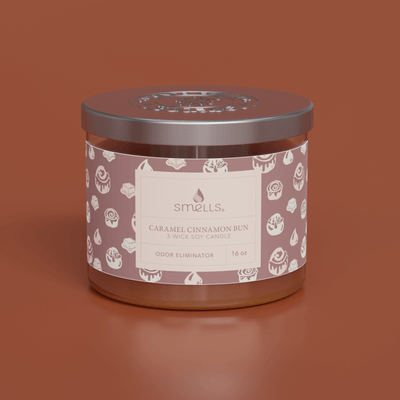A Step-By-Step Guide on How to Fix a Scented Candle Flame that is too High
You may notice that sometimes after lighting a candle, the flame can become very high. You may begin to wonder, “why is my candle flame so high?” An overly high candle flame can cause candle users concern, and for a good reason. A flame that is too high can create potential fire hazards. Therefore, learning how to fix it can help prevent dangerous situations.

Table of Contents
So, what steps should be taken to reduce a 3-wick scented candle flame that is too high? First, let’s get to the bottom of WHY your candle flame is far larger than it should be.
Why is Your Candle Flame High?
Your candle flame is rising higher than it should be for several reasons. It can be helpful to identify the cause of the problem in order to begin to solve it. If you are wondering why your candle flame is so high, then here are a few possible reasons:
The Wick is too Long
It is common for a candle flame to be too high because of an excessively tall wick. Higher wicks allow more oxygen to reach the flame, making candles brighter and burn longer. Once you've lit the candle, cut the wick short and let it burn for a few minutes to fix this problem.
The Wax is too Thick
It will take longer for a candle to light if the wax is thick. Thick wax has a harder time finding its own level since it is more viscous, or heavy and sticky. In turn, this can cause the wick to burn on top of wax that is not melting efficiently, causing the flame to remain high. Try using candle wax with a lower viscosity if your candle fails to ignite
Wind Drafts
It is likely that your candle will burn higher if it is placed in a drafty area, as the flame will have to work more vigorously to stay lit and be pulled higher into the air. Drafts can take many forms, but in most cases, you will feel a cool or warm breeze blowing directly on your candles or nearby. Your candle should be placed on a surface that is not drafty to reduce this risk.
Vibrations in the Air
Vibrations in the air may be the cause of your candle's flickering flame and rise higher than normal. These vibrations can be caused by air conditioners, ceiling fans, and even the ground. A solid surface, such as stone or glass, will help your candle burn more steadily.
Candle Age
Candle age can cause your scented candle wick to be high. The height at which your candles burn may be unnatural if you've had them for a long time. In the process of burning a candle, the candle will shrink, resulting in a wax pool that rises. When placed on top of a flat plate or in a holder with less depth.
Step-By-Step Fix for a High Candle Flame
Start by identifying the cause of your high flame. If the overly high flame height is being caused by vibration, air flow, or draft, try moving the candle to a safer and more stable environment. If this does not work, it is most likely not the reason for your high flame.

Unfortunately, if the cause of a tall flame is the wax and its consistency, there is not much you can do about it. We suggest purchasing candles made from thinner waxes. You can check out our selection of premium scented candles to avoid high-wick flames in the future.
If the cause of your flame height is due to an overly long wick, put the candle out and begin the trimming process. Continue reading to learn how to trim your scented candle wick properly.
How to Trim Your Candle Wick
Follow these instructions to properly trim your wick if your scented candle flame is too high.

Step 1: Extinguish the flame of the candle and allow it to cool to room temperature
Step 2: The second step is to use a wick trimmer or other cutting tool to bring the blades as parallel to the wax as possible as you trim the wick.
Step 3: The wick should be trimmed to a height of 1/4 inch above the wax.
Step 4: To prevent the wick debris from falling into the wax, allow the blades to catch it as you cut. There are special blades designed for this purpose on wick trimmers.
Step 5: Into a waste bin, dispose of the excess soot and debris.
Side Note: If you do not have proper wick trimmers, you can use a pair of scissors or nail clippers instead.
Why you Should Trim Your Wick
Increases the candle’s lifespan: It is common for cotton and wood wicks to split as they burn. The charred pieces may fall into the wax, causing debris near the base of the wick. As a result, if the debris is not cleared away, it can be picked up by the flame. This can cause your candle to burn hotter and faster than it was intended to.
Prevents smoke and soot: You should trim the wicks of your candles on a regular basis in order to prevent larger flames from forming, which will produce excessive amounts of smoke and soot in your home.
Helps avoid tunneling: When candles are not properly cared for, they tunnel. A narrow, vertical tunnel is formed in the center of your candle as only a small portion of the wax around the wick melts as your candle burns instead of melting evenly around the wick. An untrimmed wick can cause a flame to burn too hot.
Frequently Asked Questions (FAQ)
How high should a flame be on a candle?
There should be approximately 1 12" to 2 2" of height between the flame and the candle, with the smaller candles being closer to 1 12" and the larger candles going up to as high as 2".
Why shouldn't candles burn longer than 4 hours?
When a candle is burned for more than 4 hours, the risk of a fire spreading increases, this is because there becomes a lot of soot and build-up on the wick. If your flame is burning high and there is thick smoke or mushrooms, put your candle out immediately and follow our wick-trimming procedure.
Should you light all 3 wicks?
Yes. You should light all 3 wicks on a tri-wick candle. This will help ensure that the candle burns evenly and can sustain a longer lifespan!
What are the benefits of trimming your candle wick?
Trimming your candle wick promotes a healthy candle. With simple trimming, you can increase the lifespan of your scented candle, avoid high flames, reduce soot and smoke, and stop candle tunneling.









Leave a comment